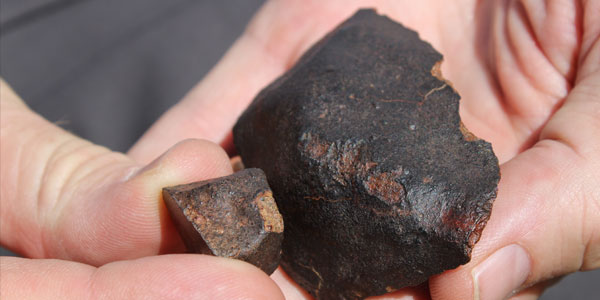South Africa’s meteorite heritage grow to over 50
- Wits University
Discovery of two meteorites are the first to be found by a member of the public on South African soil in over 40 years.
As South Africa is celebrating heritage month, the country’s meteorite heritage has grown to over 50, with two recent new discoveries by a South African farmer, Gideon Lombaard. The new discoveries, which Lombaard has made in the Northern Cape Province, push the listed meteorite mark from the previous 49, to 51.

Wits University geologists, Professors Roger Gibson and Lew Ashwal, were alerted to the new discoveries in 2021, when Lombaard reached out to them via Gabriel Goncalves from the University of Sao Paulo in Brazil to confirm whether the rocks that he had picked up on his farm south of Pofadder on 18 September 2018 and 27 August 2021 respectively were actually meteorites.
If proved correct, these would be the first discoveries by a member of the public in South Africa in over 40 years.
“Once we were able to examine the fragments, using a range of petrological and geochemical techniques, we were able to not only confirm that they were meteorites, but also to show that the two were distinctly different, despite being found only one kilometre apart,” says Gibson.
The Brierskop meteorite is a 21.19 g ordinary chondrite. The excellent state of preservation of the fusion crust distinguishes it from the more oxidised larger (90.26 g) Wolfkop stone, which is also an ordinary chondrite and which he found only 1 km away three years later. The more advanced oxidation suggests that Wolfkop belongs to an older fall than Brierskop.
In August this year, the Nomenclature Committee of the Meteoritical Society, which adjudicates all new meteorite submissions, formally accepted the researchers’proposal that the two constituted different meteorites and that they be named, respectively, Brierskop and Wolfkop after their find sites.
A meteorite is a piece of rocky Space debris that survives collision with Earth. Meteorites have been the subject of public fascination, awe, myths and even religious worship for thousands of years. They are highly sought after by museums and private collectors alike, and in recent decades have become a cosmic Rosetta Stone for scientists investigating the birth throes of our Solar system and the organic life that it hosts. Meteorites are therefore rightly classified as an integral part of our communal natural heritage, and are protected by law in South Africa.
“There are currently over 72,000 documented meteorites that have been collected across the world, weighing approximately 700 tonnes,” says Gibson. “However, while this may sound impressive, the entire meteorite collection of the world could actually fit into a cube with edges of only 6 m!”
The meteorite inventory is also very skewed by collections from only two regions – approximately 42,000 meteorites have been collected in Antarctica via systematic searches by scientific parties in Antarctica over the last 30 years, and close to 14,000 have been collected in the Sahara Desert by nomadic tribes as an income source for selling to collectors. Despite this bias, meteorite entries exist for 122 countries globally, and some have even been retrieved from dredged sediments from the seafloor.
“Earth is under continuous daily bombardment by millions of rock particles from Space, as can be witnessed by anyone viewing the clear night sky in an area away from bright lights. Each meteor, or “shooting star”, represents a tiny dust-sized particle entering the upper atmosphere and burning up,” says Gibson.
In recent decades, sensor systems tracking high-energy disturbances in the upper atmosphere have established that, on average, between 10 and 50 meteorites are likely to hit Earth’s surface every day. Most of these would splash down in the oceans, but an increasing number of countries are starting to install camera networks (such as NASA’s CAMS; seti.org/cams) specifically designed to record the trajectories of meteor fireballs that can then be triangulated to try to locate the fall site. Ground searches for fallen meteorites are becoming an increasingly popular form of citizen science.
“Finding meteorites is not easy, which makes Mr Lombaard’s twin discoveries all the more significant. Universities and museums are frequently contacted by people who believe they may have found a meteorite but almost invariably these turn out to be smelter slag, magnetite or sand-polished stones called ventifacts, all of which are quite common in the arid landscape of southern Africa.”
Meteorite fragments from the Asteroid Belt can be divided into two broad groups - undifferentiated meteorites, called chondrites, and differentiated meteorites that are separated into achondrites and irons. As the Sun formed and flared to life, mm-sized, spherical, frozen melt particles and dust began to coalesce into larger solid bodies that ultimately would grow into the rocky planets in the inner solar system and smaller bodies in the Asteroid Belt. The decay of radioactive elements and gravitational collapse caused these bodies to start heating up. Those that were too small to heat up significantly, or which were broken apart too soon by collisions with other bodies, are the source of chondrite meteorites. Chondrites are the oldest rocks in our Solar System, giving ages as old as 4.56 billion years.
“Some chondrites actually contain small particles that are even older than our Sun,” says Gibson. “They are snapshots of how our planet was formed. We can’t drill down into the core of the Earth to directly see what it is made of, but meteorites give us a good idea of what we would find and how it all started.”
